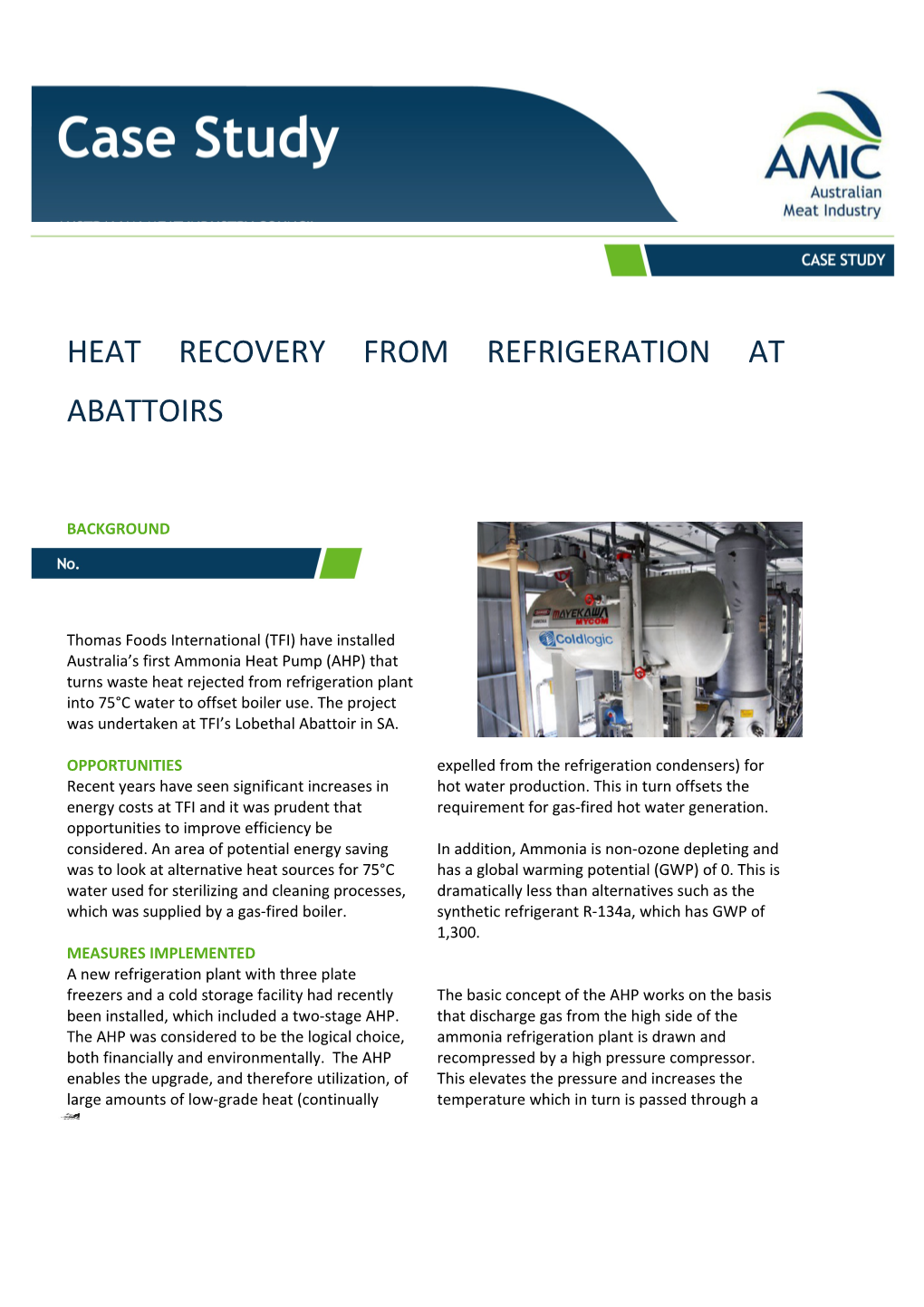Heat recovery from refrigeration at abattoirs
BACKGROUND
Thomas Foods International (TFI) have installed Australia’s first Ammonia Heat Pump (AHP) that turns waste heat rejected from refrigeration plant into 75°C water to offset boiler use. The project was undertaken at TFI’s Lobethal Abattoir in SA.
OPPORTUNITIES
Recent years have seen significant increases in energy costs at TFI and it was prudent that opportunities to improve efficiency be considered. An area of potential energy saving was to look at alternative heat sources for 75°C water used for sterilizing and cleaning processes, which was supplied by a gas-fired boiler.
MEASURES IMPLEMENTED
A new refrigeration plant with three plate freezers and a cold storage facility had recently been installed, which included a two-stage AHP. The AHP was considered to be the logical choice, both financially and environmentally. The AHP enables the upgrade, and therefore utilization, of large amounts of low-grade heat (continually expelled from the refrigeration condensers) for hot water production. This in turn offsets the requirement for gas-fired hot water generation.
In addition, Ammonia is non-ozone depleting and has a global warming potential (GWP) of 0. This is dramatically less than alternatives such as the synthetic refrigerant R-134a, which has GWP of 1,300.
The basic concept of the AHP works on the basis that discharge gas from the high side of the ammonia refrigeration plant is drawn and recompressed by a high pressure compressor. This elevates the pressure and increases the temperature which in turn is passed through a heat exchanger where it transfers its heat to water on the other side.
The evaporated ammonia from the freezer is returned to a low temperature (LT) vessel at -40°C saturated suction temperature (SST) and low pressure at -30 kPa. The ammonia is then diverted to a booster compressor, where it is compressed to 190kPa and -10°C saturated condensing temperature (SCT). It is then passed through an intercooler, followed by a number of high stage compressors, where it is compressed to 1,050kPa or 30°C SST.
A conventional design would involve transferring the ammonia to a water-cooled evaporative condenser for condensing back to a liquid. However, the design at TFI Lobethal enables the 30°C SST ammonia to be diverted to the heat pump compressors where it is boosted from 1,050kPa to 4,200kPa. This forces the ammonia through heat exchanger which heats incoming water from 11°C up to 80°C.
The hot water is delivered to a thermal storage tank. Most of the water is used at night during washdown for sanitization and cleaning. The tank is refilled during the day when there is little call for hot water.
The AHP is elevated 4.5m above the receiver to allow the liquid ammonia to drain back to the receiver. The overall refrigeration process and the heat pump integration is depicted in Figure 1.
OUTCOMES
The project has reduced energy costs at the site by approximately 40pc and CO2 emissions by 350tonnes per year. The amount of water being evaporated in evaporative condensers has also been reduced by as much as 119kL a week.
Other positive outcomes are that Ammonia is a natural refrigerant with zero GWP, is non-ozone depleting, is a cheap refrigerant compared to other synthetic refrigerants, is a very efficient and is safe when designed and implemented correctly.
